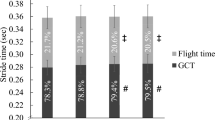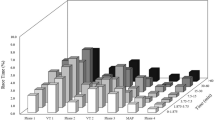Abstract
The purpose of this study was to evaluate fitness and health adaptations from a training program riding all-terrain vehicles (ATV) and off-road motorcycles (ORM) as the exercise stimulus. Participants (n = 58) were randomized to a control group (n = 12) or one of four experimental groups; 2 days/week ATV (n = 11), 2 days/week ORM (n = 12), 4 days/week ATV (n = 11), or 4 days/week ORM (n = 12). Aerobic fitness, musculoskeletal fitness, body composition, clinical health, and quality of life (QOL) were compared at baseline and following 6 weeks of training. In all riding groups, there were improvements in blood pressure (SBP = 9.4 ± 10.1, DBP = 5.8 ± 6.2 mmHg), fasting glucose (0.5 ± 0.7 mmol/l), subcutaneous adiposity (0.9 ± 1.1%), body mass (0.7 ± 2.7 kg), waist circumference (1.3 ± 2.5 cm), and isometric leg endurance (26 ± 44 s). All changes were of moderate to large magnitude (Cohen’s d 0.52–0.94) with the exception of a small loss of body mass (Cohen’s d = 0.27). Although changes occurred in the riding groups for aerobic power (2.9 ± 4.6 ml kg−1 min−1), leg power (172 ± 486 w), and curl-ups (13.2 ± 22.7), these changes were not significantly different from the control group. No significant alterations occurred in resting heart rate, trunk flexibility, back endurance, hand grip strength, long jump, pull/push strength, or push-up ability as a result of training. Physical domain QOL increased in all 2 days/week riders but mental domain QOL increased in all ORM, but not ATV riders regardless of volume. Ambient carbon monoxide levels while riding (<30 ppm) were within safe exposure guidelines. Positive adaptations can be gained from a training program using off-road vehicle riding as the exercise stimulus.


Similar content being viewed by others
References
Adir Y, Merdler A, Ben Haim S, Front A, Harduf R, Bitterman H (1999) Effects of exposure to low concentrations of carbon monoxide on exercise performance and myocardial perfusion in young healthy men. Occup Environ Med 56:535–538
American Diabetes Association (2009) Diagnosis and classification of diabetes mellitus. Diabetes Care 32(Suppl 1):S62–S67. doi:10.2337/dc09-S062
Arroll B, Beaglehole R (1992) Does physical activity lower blood pressure: a critical review of the clinical trials. J Clin Epidemiol 45:439–447
Baum K, Votteler T, Schiab J (2007) Efficiency of vibration exercise for glycemic control in type 2 diabetes patients. Int J Med Sci 4:159–163
Brill PA, Macera CA, Davis DR, Blair SN, Gordon N (2000) Muscular strength and physical function. Med Sci Sport Exerc 32:412–416
Burr JF, Jamnik VK, Gledhill N (2010a) A cross-sectional examination of the physical fitness and selected health attributes of recreational all-terrain vehicle riders and off road motorcyclists. J Sport Sci (in press)
Burr JF, Jamnik VK, Gledhill N (2010b) Health-related quality of life of habitual recreational off-road vehicle riders. HFJC (in press)
Burr JF, Jamnik VK, Shaw JA, Gledhill N (2010c) Physiological demands of off-road vehicle riding. Med Sci Sport Exerc 42:1345–1354. doi:10.1249/MSS.0b013e3181cd5cd3
Burr JF, Rowan CP, Jamnik VK, Riddell MC (2010d) The role of physical activity in type 2 diabetes prevention: physiological and practical perspectives. Phys Sportsmed 38:72–82. doi:10.3810/psm.2010.04.1764
Canadian Society for Exercise Physiology (2004) The Canadian physical activity, fitness and lifestyle approach. In: Anonymous, 3rd edn. CSEP H&FP, Ottawa
Chobanian AV, Bakris GL, Black HR et al (2003) The seventh report of the joint national committee on prevention, detection, evaluation, and treatment of high blood pressure: the JNC 7 report. JAMA 289:2560–2572. doi:10.1001/jama.289.19.2560
Cordell HK, Betz CJ, Green GT, Stephens B (2008) Off-highway vehicle recreation in the United States and its regions and states: an update national report from the National survey on recreation and the environment (NSRE). US Forest Service, Washington DC
Durnin JV, Womersley J (1974) Body fat assessed from total body density and its estimation from skinfold thickness: measurements on 481 men and women aged from 16 to 72 years. Br J Nutr 32:77–97
Fagard RH (2006) Exercise is good for your blood pressure: effects of endurance training and resistance training. Clin Exp Pharmacol Physiol 33:853–856. doi:10.1111/j.1440-1681.2006.04453.x
Favory R, Lancel S, Tissier S, Mathieu D, Decoster B, Neviere R (2006) Myocardial dysfunction and potential cardiac hypoxia in rats induced by carbon monoxide inhalation. Am J Respir Crit Care Med 174:320–325. doi:10.1164/rccm.200601-117OC
Flachsbart PG (1999) Human exposure to carbon monoxide from mobile sources. Chemosphere: Glob Chang Sci 1:301–329
Goodpaster BH, Kelley DE, Wing RR, Meier A, Thaete FL (1999) Effects of weight loss on regional fat distribution and insulin sensitivity in obesity. Diabetes 48:839–847
Horner J (1998) Carbon monoxide: the invisible killer. J R Soc Promot Health 118:141–145
Katzmarzyk PT, Craig CL (2002) Musculoskeletal fitness and risk of mortality. Med Sci Sport Exerc 34:740–744
Keir PJ, Jamnik VK, Gledhill N (2003) Technical-methodological report: a nomogram for peak leg power output in the vertical jump. J Strength Cond Res 17:701–703
Lee S, Kuk JL, Davidson LE et al (2005) Exercise without weight loss is an effective strategy for obesity reduction in obese individuals with and without Type 2 diabetes. J Appl Physiol 99:1220–1225. doi:10.1152/japplphysiol.00053.2005
Liu J, Hanley AJ, Young TK, Harris SB, Zinman B (2006) Characteristics and prevalence of the metabolic syndrome among three ethnic groups in Canada. Int J Obes (Lond) 30:669–676. doi:10.1038/sj.ijo.0803179
Mason C, Brien SE, Craig CL, Gauvin L, Katzmarzyk PT (2007) Musculoskeletal fitness and weight gain in Canada. Med Sci Sport Exerc 39:38–43. doi:10.1249/01.mss.0000240325.46523.cf
NIOSH (1992) Recommendations for occupational safety and health: compendium of policy documents and statements, Cincinnati, pp 92–100
Peach HG, Bath NE (1999) Prevalence and sociodemographic determinants of cardiovascular risk in a rural area. Aust J Rural Health 7:23–27
Peters PG, Alessio HM, Hagerman AE, Ashton T, Nagy S, Wiley RL (2006) Short-term isometric exercise reduces systolic blood pressure in hypertensive adults: possible role of reactive oxygen species. Int J Cardiol 110:199–205. doi:10.1016/j.ijcard.2005.07.035
Ross R, Dagnone D, Jones PJ et al (2000) Reduction in obesity and related comorbid conditions after diet-induced weight loss or exercise-induced weight loss in men. A randomized, controlled trial. Ann Intern Med 133:92–103
Sigal RJ, Kenny GP, Wasserman DH, Castaneda-Sceppa C, White RD (2006) Physical activity/exercise and type 2 diabetes: a consensus statement from the American diabetes association. Diabetes Care 29:1433–1438. doi:10.2337/dc06-9910
Thompson PD, Buchner D, Pina IL et al (2003) Exercise and physical activity in the prevention and treatment of atherosclerotic cardiovascular disease: a statement from the council on clinical cardiology (subcommittee on exercise, rehabilitation, and prevention) and the council on nutrition, physical activity, and metabolism (subcommittee on physical activity). Circulation 107:3109–3116. doi:10.1161/01.CIR.0000075572.40158.77
Walker SM, Ackland TR, Dawson B (2001) The combined effect of heat and carbon monoxide on the performance of motorsport athletes. Comp Biochem Physiol A 128:709–718
Warburton DE, Gledhill N, Quinney A (2001) The effects of changes in musculoskeletal fitness on health. Can J Appl Physiol 26:161–216
Warburton DE, Nicol CW, Bredin SS (2006) Health benefits of physical activity: the evidence. CMAJ 174:801–809. doi:10.1503/cmaj.051351
Warda L, Klassen TP, Buchan N, Zierler A (1998) All terrain vehicle ownership, use, and self reported safety behaviours in rural children. Inj Prev 4:44–49
Ware JE Jr, Kosinski M (2007) SF-36 physical and mental health summary scales: a manual for users of version 1. In: Anonymous Quality Metric Incorporated, Lincoln
Ware JE Jr, Sherbourne CD (1992) The MOS 36-item short-form health survey (SF-36). I. Conceptual framework and item selection. Med Care 30:473–483
Acknowledgments
This study was supported through a research grant provided by the Canadian Off-Highway Vehicles Distributors Council which included funds from both private and government sources.
Conflict of interest
The authors declare no conflict of interest in professional relationships by which they would benefit from the results of this study.
Author information
Authors and Affiliations
Corresponding author
Additional information
Communicated by Susan A. Ward.
Rights and permissions
About this article
Cite this article
Burr, J.F., Jamnik, V.K. & Gledhill, N. Physiological fitness and health adaptations from purposeful training using off-road vehicles. Eur J Appl Physiol 111, 1841–1850 (2011). https://doi.org/10.1007/s00421-010-1817-8
Received:
Accepted:
Published:
Issue Date:
DOI: https://doi.org/10.1007/s00421-010-1817-8




